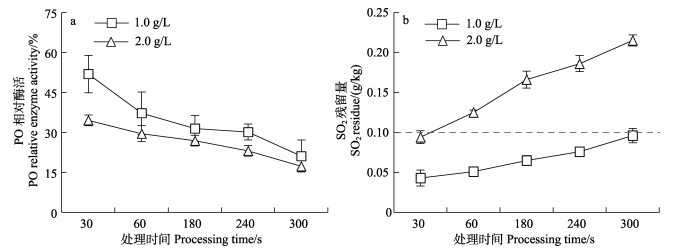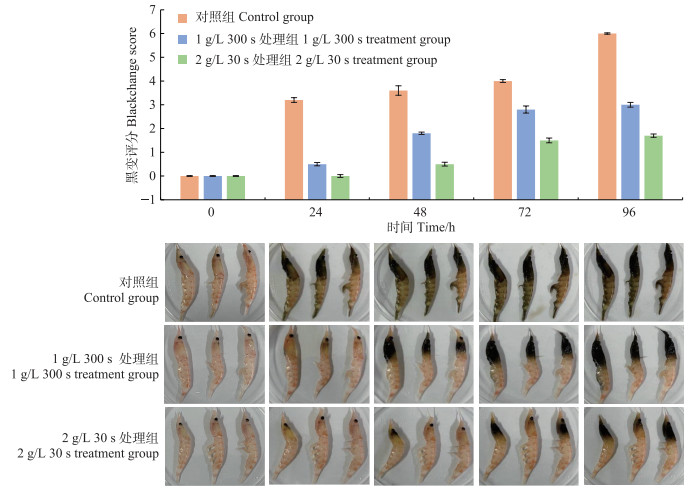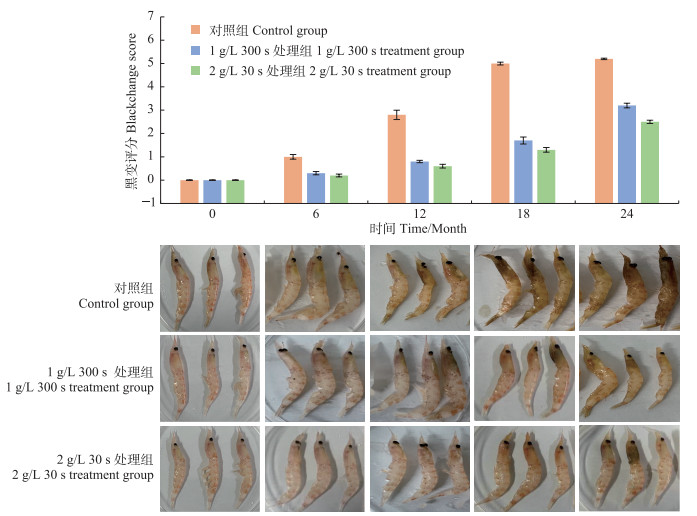2. 中国海洋大学食品科学与工程学院 山东 青岛 266404;
3. 青岛海洋科技中心 海洋药物与生物制品功能实验室 山东 青岛 266235
2. College of Food Science and Engineering, Ocean University of China, Qingdao 266404, China;
3. Marine Drugs and Biological Products Functional Laboratory, Qingdao Marine Science and Technology Center, Qingdao 266235, China
南极磷虾(Euphausia superba)隶属节肢动物门(Arthropoda)、软甲纲(Malacostraca)、磷虾目(Euphausiacea)、磷虾科(Euphausiidae)、磷虾属(Euphausia),广泛分布于环南极大陆架水域,是南极生态系统中的重要组成物种(楼乔明等, 2012)。南极磷虾生物资源量巨大,营养价值高,已成为南大洋中重要的商业化渔业资源(Nicol et al, 2012; 曹荣等, 2018; Kim et al, 2014)。南极磷虾具有非常高的自溶酶活性,在加工贮运过程中易发生自溶、黑变等现象(Zheng et al, 2022; 李学英等, 2014),导致南极磷虾原料感官品质劣化和营养价值下降。钱韻芳等(2012)研究表明,虾类黑变是由体内的酚氧化酶(phenoloxidase, PO)介导的一系列酶促反应的结果。PO可以促进酚类物质氧化,生成的醌类化合物极不稳定,进一步反应生成黑色素(Luna-Acosta et al, 2017)。黑色素的聚集不仅会严重影响南极磷虾的外观,而且影响南极磷虾的品质,降低其商业价值。因此,南极磷虾贮运过程中的黑变控制尤为重要。
目前,在虾黑变控制方面,主要采用的是化学手段,即通过添加还原剂(Bonerba et al, 2013; Nirmal et al, 2012)、金属离子螯合剂(迟海等, 2011)以及PO的结构类似物(Montero et al, 2004)等,也有学者研究了低温、气调包装、超高压处理等物理手段在虾类货架期延长方面的作用(Pan et al, 2019; Wu et al, 2023; 凌萍华等, 2010),但均存在成本过高的问题。亚硫酸盐类因具有使用成本低、抑制黑变效果好等优点,是目前普遍采用的虾类抑黑剂(Hardisson et al, 2002; Ren et al, 2022; 田静等, 2018)。焦亚硫酸钠是GB 2760-2014中允许用作抗氧化剂、防腐剂的化合物之一,焦亚硫酸钠可以抑制PO活性,或将醌类化合物还原,从而达到抑制黑变的效果(López-Caballero et al, 2019),还可以通过SO2的还原作用扰乱微生物的正常代谢,抑制微生物的生长繁殖(黄安妮等, 2023)。如林瑞环等(2021)研究发现,焦亚硫酸钠可较好地抑制南极磷虾体内的PO活力,杨峰等(2020)也发现,焦亚硫酸钠可延缓南极磷虾的黑变。但亚硫酸盐的过量使用容易引起肠胃、肝脏等不适,导致呼吸困难、呕吐腹泻、头疼等(陈健敏等, 2021),然而,GB 2760-2014中只明确规定了SO2残留量应不超过0.1 g/kg,缺少加工过程中的使用限量标准要求,目前生产中对焦亚硫酸钠的使用比较粗放,有关如何规范使用焦亚硫酸钠的文献报道也很少。
本研究考察了不同浓度的焦亚硫酸钠溶液和浸泡时间对南极磷虾虾体SO2残留量、PO活力的影响,在此基础上,确立了较优处理工艺,并验证了防黑变效果。研究结果可以为焦亚硫酸钠在南极磷虾中的规范使用提供参考。
1 材料与方法 1.1 材料与试剂南极磷虾由中国水产有限公司于2022年4月在南极海域捕捞,以虾砖的形式–20 ℃冷冻贮藏和运输,运至实验室后用于各项实验。
L-3, 4-二羟基苯丙氨酸(L-DOPA)、十二烷基聚乙二醇醚(Brij-35)均为分析纯,购于上海阿拉丁生化科技股份有限公司;焦亚硫酸钠、可溶性淀粉、硫代硫酸钠、碘、碘化钾、盐酸、乙酸铅、磷酸二氢钠和磷酸氢二钠等试剂均为分析纯,购于国药集团化学试剂有限公司。
1.2 仪器与设备ME204型分析天平[梅特勒托利多科技(中国)有限公司];HH-4型数显恒温水浴锅(国华科技有限公司);YC-2型层析实验冷柜(上海豫明仪器有限公司);2802UV/VIS型紫外分光光度计(上海UNIQUE公司);5804-R型冷冻离心机(Eppendopf公司,德国);HJ-2型磁力搅拌器(国华电器有限公司);PHS-3S型pH计(北京赛多利斯仪器系统有限公司)。
1.3 实验方法 1.3.1 样品预处理参照曹荣等(2015)的方法,取虾砖静水解冻后,挑取完整无破损、大小均一[(4.5±0.5) cm体长]的南极磷虾,随机分组进行实验。
1.3.2 焦亚硫酸钠处理工艺参照徐扬等(2022)的方法,将南极磷虾分别浸泡在1、2和3 g/L的焦亚硫酸钠溶液中30 s、60 s、180 s、240 s、300 s,取出后沥水,立即进行SO2残留量和PO活力指标的检测。另取焦亚硫酸钠溶液处理前后的样品,分别置于4 ℃冰箱和–20 ℃冰箱内贮藏,定期取样观察黑变情况。
1.3.3 南极磷虾黑变评分参照吕艳芳等(2017)的方法,观察对照组和处理组的黑变情况。评分标准如表 1所示,分值在0 (无黑变)到6 (完全黑变)范围内。感官评价小组由8名接受过相关培训的人员组成,取8人评分的平均值作为最终黑变评分。
|
|
表 1 南极磷虾黑变评分标准 Tab.1 Antarctic krill blackening score standard |
参照GB/T 5009.34- 2016《食品安全国家标准食品中二氧化硫的测定》中蒸馏法进行测定,根据碘标准溶液的消耗量计算样品中SO2的残留量。
1.3.5 PO提取及活力的测定参考Sae-Leaw等(2017)的方法略作改动,提取PO粗提液。分别将对照组和处理组样品液氮冷冻后研磨成粉,按1∶5 (W/V)的比例加入预冷的0.05 mol/L的磷酸盐缓冲液(含0.2% Brij-35,1 mol/L NaCl,pH 7.2)混匀,于4 ℃条件下搅拌30 min,8 000 r/min离心30 min,无纺布过滤,所得上清液即为PO粗提液。
参考Shiekh等(2020)的方法测定PO活力,并略作改动。以L-DOPA为底物,将1.2 mL的L-DOPA溶液(15 mmol/L)与0.8 mL磷酸盐缓冲液(0.05 mol/L,pH 6.0)、0.2 mL粗酶液混合,置于30 ℃水浴孵育3 min,在475 nm处测定其5 min内的吸光值变化。酶活力单位(U)定义为,在475 nm波长下,一定时间内将一定量的底物转换为产物所需要的酶量。酶活力用相对酶活表示,将未经焦亚硫酸钠溶液处理的南极磷虾体内的PO活力定义为100%。
1.4 数据处理每个指标平行测定3次,实验重复2次,结果以平均值±标准差(Mean±SD)表示。采用SPSS 22.0软件进行数据分析,P < 0.05表示差异显著。
2 结果与分析 2.1 焦亚硫酸钠溶液浓度对南极磷虾PO活力和虾体SO2残留量的影响南极磷虾经不同浓度的焦亚硫酸钠溶液处理180 s,PO活力和SO2残留量见图 1。当焦亚硫酸钠溶液浓度为1 g/L时,PO相对酶活为31.4%。当焦亚硫酸钠溶液浓度为2 g/L和3 g/L时,PO相对酶活分别为26.9%和18.3%,说明溶液浓度增大会提高对南极磷虾体内PO活力的抑制效果,这与Gokoglu等(2022)在巨型红虾(Aristaeomorpha foliacea)中的研究结果基本一致。由图 1b可知,南极磷虾体内的SO2残留量与焦亚硫酸钠溶液浓度呈正相关,当焦亚硫酸钠溶液浓度为1 g/L时,虾体中的SO2残留量为0.065 g/kg,低于国标0.1 g/kg的限量值;经2 g/L溶液处理后,虾体内的SO2残留量为0.166 g/kg,已超出国标限量值;经3 g/L溶液处理后,虾体内的SO2残留量达到0.254 g/kg,大幅超出国标限量范围。因此,适宜采用1 g/L或2 g/L的焦亚硫酸钠溶液进行南极磷虾防黑变处理。

|
图 1 不同浓度焦亚硫酸钠溶液处理对南极磷虾中PO活力(a)和SO2残留量(b)的影响 Fig.1 Effect of different concentrations of sodium metabisulfite solution on PO activity(a), and SO2 residue(b) in Antarctic krill 图中不同小写字母表示不同组间存在显著性差异(P < 0.05)。 Different lower case letters in the graph indicate significant differences between groups (P < 0.05). |
采用1 g/L和2 g/L的焦亚硫酸钠溶液对南极磷虾进行不同时间的处理,结果见图 2。随着处理时间的延长,2组样品的PO相对酶活均逐渐下降,与此同时SO2残留量逐渐增加,这与徐扬等(2022)在鹰爪糙对虾(Trachypenaeus curvirostris)中的研究结果一致。在SO2残留量不超过0.1 g/kg的前提下,1 g/L焦亚硫酸钠溶液处理时间可以延长至300 s,此时PO相对活力为21.2%,而2.0 g/L焦亚硫酸钠溶液适宜的处理时间为30 s,此时PO相对酶活为34.5%。由此,1 g/L焦亚硫酸钠溶液处理300 s和2 g/L焦亚硫酸钠溶液处理30 s,均可将SO2残留量控制在0.1 g/kg以下,可以作为南极磷虾黑变控制的较优工艺。而采用低浓度、长时间处理,可以更好地抑制PO活力。

|
图 2 焦亚硫酸钠溶液处理时间对南极磷虾PO活力(a)和SO2残留量(b)的影响 Fig.2 Effect of sodium metabisulfite treatment time on PO activity (a), and SO2 residue (b) in Antarctic krill |
选取1 g/L焦亚硫酸钠溶液浸泡300 s和2 g/L焦亚硫酸钠溶液浸泡30 s 2种条件对南极磷虾进行处理,观察处理前后的样品在冷藏过程中的黑变情况,结果见图 3。对照组4 ℃贮藏24 h时出现明显黑变,集中在头胸部、腹部及尾节部分,南极磷虾个体之间的黑变进程存在轻微差异,这可能与虾生前的应激程度、解冻后的组织状态以及虾死后酚氧化酶原活化进程等因素有关(林瑞环等, 2021)。与对照组相比,焦亚硫酸钠处理组在冷藏过程中的黑变评分显著低于对照组(P < 0.05),这与Zhu等(2020)的研究结果一致。1 g/L焦亚硫酸钠溶液300 s处理组与2 g/L焦亚硫酸钠溶液30 s处理组分别在冷藏48 h和72 h时虾体出现明显黑变,表明处理时焦亚硫酸钠溶液浓度越高,对南极磷虾冷藏过程中的黑变控制效果越好。另外,PO活力仅是影响黑变进程的因素之一。尽管1 g/L焦亚硫酸钠溶液处理300 s可以更好地抑制PO活力,但冷藏过程中,该组的防黑效果不如2 g/L焦亚硫酸钠溶液30 s处理组。

|
图 3 焦亚硫酸钠处理较优工艺对南极磷虾冷藏过程黑变的影响 Fig.3 Effect of sodium metabisulfite treatment on blackening during refrigeration of Antarctic krill |
将焦亚硫酸钠处理后的南极磷虾进行冻藏,定期取样观察黑变情况,结果见图 4。3组样品的黑变评分随冻藏时间的延长而逐渐升高。其中,对照组在冻藏6个月后,虾头出现轻微黑变,冻藏12个月后,尾部也出现黑变,在冻藏24个月时大部分南极磷虾已达到感官不可接受的程度。而处理组的黑变评分均显著低于对照组,2组样品在冻藏12个月后虾头开始出现黑变,说明焦亚硫酸钠处理有效延缓了冻藏过程中南极磷虾黑变的发生。在同一取样点,2 g/L焦亚硫酸钠溶液30 s处理组的虾体的黑变程度更轻,说明高浓度焦亚硫酸钠溶液、短时处理对黑变抑制的效果更优。

|
图 4 焦亚硫酸钠处理较优工艺对南极磷虾冻藏过程黑变的影响 Fig.4 Effect of sodium metabisulfite treatment on blackening during freezing of Antarctic krill |
本研究对焦亚硫酸钠处理南极磷虾的防黑保鲜工艺进行了研究,研究发现,虽然焦亚硫酸钠在虾的黑变控制方面有一定的效果,但使用过程容易出现SO2超标的问题。目前的研究多集中在开发天然保鲜剂以及与焦亚硫酸盐复配使用等方面。如G´omez-Guill´en等(2005)研究发现,柠檬酸可提升亚硫酸盐对摩洛哥冷冻虾(Parapenaeus longirostris)黑变的抑制效果;Lόpez-Caballero等(2007)也发现,葡萄糖酸与亚硫酸盐相结合是一种有前景的抑黑剂。此外,辣木叶(Moringa oleifera)提取物(Karim et al, 2018)、鳄梨(Persea americana Mill.)提取物(Phan et al, 2021)、腰果(Anacardium occidentale L.)叶提取物(Sae-Leaw et al, 2019)及壳聚糖(Isfran et al, 2023; Liu et al, 2020; 姚洁玉等, 2019)等天然物质也展现出良好的防黑保鲜效果。后续可进一步研究不同物质的协同效益,开发成本更低、安全性更高、效果更理想的防黑保鲜剂。
3 结论南极磷虾经1 g/L焦亚硫酸钠溶液浸泡300 s和2 g/L焦亚硫酸钠溶液浸泡30 s,其PO相对酶活分别为21.2%和34.5%;对应的SO2残留量分别为0.094 g/kg和0.096 g/kg,均符合GB 2760-2014要求。焦亚硫酸钠溶液处理可以延缓南极磷虾贮藏过程中的黑变进程,且2 g/L焦亚硫酸钠溶液浸泡30 s的防黑效果更佳。研究结果可为南极磷虾贮运过程中的品质保持提供技术参考。
BONERBA E, CECI E, BOZZO G, et al. Analysis of the sulphite content in shrimps and prawns. Italian Journal of Food Safety, 2013, 2(2): 18 DOI:10.4081/ijfs.2013.e18 |
CAO R, CHEN Y, ZHAO Y R, et al. Effect of thawing methods on processing quality of Antarctic krill. Transactions of the Chinese Society of Agricultural Engineering, 2015, 31(17): 289-294 [曹荣, 陈岩, 赵玉然, 等. 解冻方式对南极磷虾加工品质的影响. 农业工程学报, 2015, 31(17): 289-294 DOI:10.11975/j.issn.1002-6819.2015.17.038] |
CAO R, ZHAO L, SUN H H, et al. Nutritional characteristics and umami assessment of Euphausia superba and Exopalaemon carinicauda. Food Science, 2018, 39(4): 149-153 [曹荣, 赵玲, 孙慧慧, 等. 南极磷虾(Euphausia superba)与脊尾白虾(Exopalaemon carinicauda)营养学特征分析及鲜味评价. 食品科学, 2018, 39(4): 149-153] |
CHEN J M, RAN M N, WANG M X. Research progress of sulfites in food. Journal of Nuclear Agricultural Sciences, 2021, 35(7): 1639-1647 [陈健敏, 冉梦楠, 王美霞. 亚硫酸盐在食品中的研究进展. 核农学报, 2021, 35(7): 1639-1647] |
CHI H, LI X Y, HANG Y J, et al. Influences of food addictive on protein autolysis of Euphausia superba. Marine Fisheries, 2011, 33(3): 346-351 [迟海, 李学英, 杭虞杰, 等. 食品添加剂对南极大磷虾蛋白自溶的影响. 海洋渔业, 2011, 33(3): 346-351 DOI:10.3969/j.issn.1004-2490.2011.03.014] |
GOKOGLU N, GUMUS B, CEYLAN A, et al. Storage in ice incorporated antimelanotic agent and its effects on melanosis and quality of giant red shrimp (Aristaeomorpha foliacea). Food Bioscience, 2022, 46: 101599 DOI:10.1016/j.fbio.2022.101599 |
GÓMEZ-GUILLÉN M C, MARTÍNEZ-ALVAREZ Ó, LLAMAS A, et al. Melanosis inhibition and SO2 residual levels in shrimps (Parapenaeus longirostris) after different sulfite- based treatments: Melanosis inhibition and SO2 residual levels in shrimps. Journal of the Science of Food and Agriculture, 2005, 85(7): 1143-1148 DOI:10.1002/jsfa.1990 |
HARDISSON A, RUBIO C, FRÍAS I, et al. Content of sulphite in frozen prawns and shrimps. Food Control, 2002, 13(4): 275-279 |
HUANG A N, MA H X, LI H Q, et al. Study on the preservation effect of sodium pyrosulfite on Litopenaeus vannamei. Modern Agricultural Equipment, 2023, 44(1): 64-70 [黄安妮, 马海霞, 李浩权, 等. 焦亚硫酸钠对凡纳滨对虾的保鲜效果研究. 现代农业装备, 2023, 44(1): 64-70] |
ISFRAN D, CHACON W D C, ALVES M J DOS S, et al. Active films and coatings based on propolis extract and chitosan: Physicochemical characterization and potential application in refrigerated shrimps (Litopenaeus vannamei). Starch-Stä rke, 2023, 2200263 |
KARIM N U, SIDDIQ U S A A, RAZAK M R M, et al. Effects of moringa leaves (Moringa oleifera) extraction on quality changes and melanosis of giant freshwater prawn (Macrobrachium rosenbergii) during chilled storage. Italian Journal of Food Safety, 2018, 7(3): 6846 |
KIM M A, JUNG H R, LEE Y B, et al. Monthly variations in the nutritional composition of Antarctic krill Euphausia superba. Fisheries and Aquatic Sciences, 2014, 17(4): 409-419 DOI:10.5657/FAS.2014.0409 |
LI X Y, LIU H X, YANG X S, et al. Effects of temperature on the quality of Antarctic krill (Euphausia superba) during frozen storage. Modern Food Science and Technology, 2014, 30(6): 191–195, 6 [李学英, 刘会省, 杨宪时, 等. 冻藏温度对南极磷虾品质变化的影响. 现代食品科技, 2014, 30(6): 191–195, 6] |
LIN R H, ZHAO L, CAO R, et al. Comparative analysis on the biochemical properties of phenoloxidase isolated from Euphausia superba and Trachypenaeus curvirostris. Progress in Fishery Sciences, 2021, 42(2): 124-131 [林瑞环, 赵玲, 曹荣, 等. 南极磷虾与鹰爪糙对虾酚氧化酶生化性质对比分析. 渔业科学进展, 2021, 42(2): 124-131] |
LING P H, XIE J. Evaluation of techniques and freshness keeping effect of modified atmosphere-packaging (MAP) on Pacific white shrimp. Packaging Engineering, 2010, 31(9): 10-14 [凌萍华, 谢晶. 南美白对虾气调包装工艺及保鲜效果评价. 包装工程, 2010, 31(9): 10-14] |
LIU B, PAN S. Effect of chitosan coatings incorporated sodium phytate on the shelf-life of Antarctic krill (Euphausia superba). International Journal of Biological Macromolecules, 2020, 151: 62-65 DOI:10.1016/j.ijbiomac.2020.02.148 |
LOU Q M, WANG Y M, YANG W G, et al. Lipid classes and fatty acid compositions of Antarctic krill meal. Journal of Fisheries of China, 2012, 36(8): 1256-1262 [楼乔明, 王玉明, 杨文鸽, 等. 南极磷虾粉脂质及脂肪酸组成分析. 水产学报, 2012, 36(8): 1256-1262] |
LÓPEZ-CABALLERO M E, MARTÍNEZ-ALVAREZ O, GÓMEZ-GUILLÉN M DEL C, et al. Quality of thawed deepwater pink shrimp (Parapenaeus longirostris) treated with melanosis-inhibiting formulations during chilled storage. International Journal of Food Science and Technology, 2007, 42(9): 1029-1038 DOI:10.1111/j.1365-2621.2006.01328.x |
LÓPEZ-CABALLERO M E, MARTÍNEZ-ÁLVAREZ O, GÓMEZ-GUILLÉN M C, et al. Several melanosis- inhibiting formulas to enhance the quality of deepwater pink shrimp (Parapenaeus longirostris). Innovative Food Science and Emerging Technologies, 2019, 51: 91-99 DOI:10.1016/j.ifset.2018.07.008 |
LUNA-ACOSTA A, BREITWIESER M, RENAULT T, et al. Recent findings on phenoloxidases in bivalves. Marine Pollution Bulletin, 2017, 122(1): 5-16 |
LÜ Y F, CAI L J, LI Y C, et al. The Comparison between compound preservatives and sodium metabisulfite treatment on the anti-melanosis effect of Penaeus vannamei under ice-temperature. Journal of Chinese Institute of Food Science and Technology, 2017, 17(7): 129-138 [吕艳芳, 蔡路昀, 李颖畅, 等. 冰温下复合保鲜剂和焦亚硫酸钠对南美白对虾防黑变保鲜效果比较. 中国食品学报, 2017, 17(7): 129-138] |
MONTERO P, MARTÍNEZ-ÁLVAREZ O, GÓMEZ-GUILLÉN M C. Effectiveness of onboard application of 4-hexylresorcinol in inhibiting melanosis in shrimp (Parapenaeus longirostris). Journal of Food Science, 2004, 69(8): 643-647 |
NICOL S, FOSTER J, KAWAGUCHI S. The fishery for Antarctic krill - recent developments: Krill fishery review. Fish and Fisheries, 2012, 13(1): 30-40 DOI:10.1111/j.1467-2979.2011.00406.x |
NIRMAL N P, BENJAKUL S. Effect of green tea extract in combination with ascorbic acid on the retardation of melanosis and quality changes of Pacific white shrimp during iced storage. Food and Bioprocess Technology, 2012, 5(8): 2941-2951 DOI:10.1007/s11947-010-0483-5 |
PAN C, CHEN S, HAO S, et al. Effect of low-temperature preservation on quality changes in Pacific white shrimp, Litopenaeus vannamei: A review. Journal of the Science of Food and Agriculture, 2019, 99(14): 6121-6128 DOI:10.1002/jsfa.9905 |
PHAN D T A, BUI T H, DOAN T Q T, et al. Inhibition of melanosis in whiteleg shrimp (Litopenaeus vannamei) during refrigerated storage using extracts of different avocado (Persea americana Mill) by-products. Preventive Nutrition and Food Science, 2021, 26(2): 209-218 DOI:10.3746/pnf.2021.26.2.209 |
QIAN Y F, XIE J, WU W H. Research progress in melanosis mechanism of shrimp products induced by phenoloxiade and the use of anti-melanosis techniques during preservation. Science and Technology of Food Industry, 2012, 33(22): 400-405 [钱韻芳, 谢晶, 吴文惠. 虾类保藏过程中酚氧化酶酶促黑变作用机理及其抑制方法的研究进展. 食品工业科技, 2012, 33(22): 400-405] |
REN Y, HUANG J, WANG X, et al. Effects of sulfite treatment on the quality of black fungus. Food Chemistry, 2022, 385: 132685 DOI:10.1016/j.foodchem.2022.132685 |
SAE-LEAW T, BENJAKUL S. Prevention of quality loss and melanosis of Pacific white shrimp by cashew leaf extracts. Food Control, 2019, 95: 257-266 DOI:10.1016/j.foodcont.2018.08.014 |
SAE-LEAW T, BENJAKUL S, SIMPSON B K. Effect of catechin and its derivatives on inhibition of polyphenoloxidase and melanosis of Pacific white shrimp. Journal of Food Science and Technology, 2017, 54(5): 1098-1107 DOI:10.1007/s13197-017-2556-1 |
SHIEKH K A, BENJAKUL S. Effect of pulsed electric field treatments on melanosis and quality changes of Pacific white shrimp during refrigerated storage. Journal of Food Processing and Preservation, 2020, 44(1): e14292 |
TIAN J, YI H L. Effect of sodium metabisulfite soaking treatment on Muscat Hamburg table grapes storage. Food Science and Technology, 2018, 43(11): 44-49 [田静, 仪慧兰. 焦亚硫酸钠溶液处理对采后玫瑰香葡萄贮藏效果的影响. 食品科技, 2018, 43(11): 44-49] |
WU S, YANG R. Effect of high-pressure processing on polyphenol oxidase, melanosis and quality in ready-to-eat crabs during storage. LWT-Food Science and Technology, 2023, 178: 114607 DOI:10.1016/j.lwt.2023.114607 |
XU Y, ZHAO L, LIU X, et al. Study on the application of sodium metabisulfite in preventing melanosis of Trachypenaeus curvirostris. Journal of Food Safety and Quality, 2022, 13(21): 6821-6827 [徐扬, 赵玲, 刘鑫, 等. 焦亚硫酸钠在虾类黑变控制中的应用研究. 食品安全质量检测学报, 2022, 13(21): 6821-6827] |
YANG F, CAI Y Q, CHI H. Influences of a compound preservative on quality changes and shelf life of Antarctic krill (Euphausia superba) at frozen temperature. Hunan Agricultural Sciences, 2020(10): 86-91 [杨峰, 蔡友琼, 迟海. 复配保鲜剂对冻藏南极大磷虾品质变化及货架期的影响. 湖南农业科学, 2020(10): 86-91] |
YAO J Y, LI Y, JIANG Y Y, et al. Optimization of chitosan-citrus essential oil microcapsules for application in the preservation of Litopenaeus vannamei. Progress in Fishery Sciences, 2019, 40(6): 203-209 [姚洁玉, 李苑, 江杨阳, 等. 壳聚糖–柑橘精油微胶囊制备工艺优化及其在凡纳滨对虾保鲜中的应用. 渔业科学进展, 2019, 40(6): 203-209] |
ZHENG Y, PING Z, XU Y, et al. Changes in the autolysis level, muscle stability and myofibrillar protein properties of Antarctic krill (Euphausia superba) during refrigerated storage. International Journal of Food Science and Technology, 2022, 57(12): 7829-7839 DOI:10.1111/ijfs.16133 |
ZHU J P, CHEN Y, JIN L, et al. Quality assessment of frozen Solenocera crassicornis treated with sodium metabisulphite by soaking or spraying. Journal of Ocean University of China, 2020, 19(1): 199-208 DOI:10.1007/s11802-020-4219-5 |



